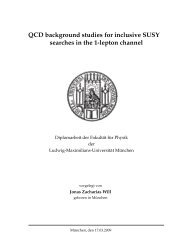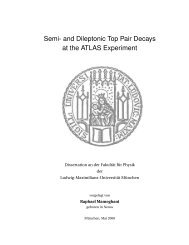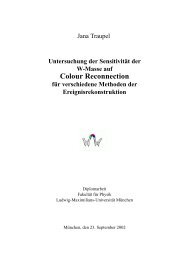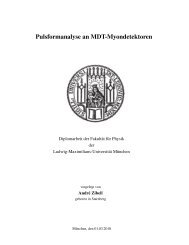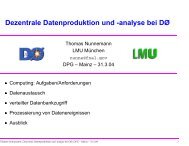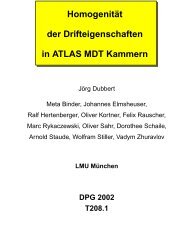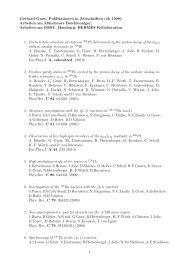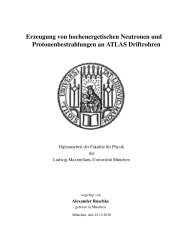development of micro-pattern gaseous detectors – gem - LMU
development of micro-pattern gaseous detectors – gem - LMU
development of micro-pattern gaseous detectors – gem - LMU
You also want an ePaper? Increase the reach of your titles
YUMPU automatically turns print PDFs into web optimized ePapers that Google loves.
6.1. Time Resolution 67<br />
The signal by cosmic muons can now be seen as a set <strong>of</strong> locally discrete charges distributed over the<br />
entire drift region. To this end we consider the maxima in the rise time histograms shown earlier as<br />
the width <strong>of</strong> an associated probability distribution <strong>of</strong> all signal times. In the case <strong>of</strong> X-ray generated<br />
events the shown signal time represents the width σt local <strong>of</strong> locally produced charges that is smeared<br />
out due to diffusion effects. Furthermore, the drift time <strong>of</strong> electrons in 4 mm drift space characterizes<br />
the width σ t dri ft<br />
<strong>of</strong> a corresponding probability function if one considers all realizable drift times.<br />
Following this argument, the combination <strong>of</strong> these statistically distributed signal and drift times results<br />
in the signal rise time σ t µ <strong>of</strong> muon events. Mathematically, this is implemented by the convolution <strong>of</strong><br />
the corresponding distribution relating the standard deviations quadratically:<br />
<br />
(σ t local )2 + (σ t dri ft )2 = σ t µ<br />
Considering signals recorded with the CATSA82 preamplifier and operation parameters as in Fig.<br />
6.1 and Fig. 6.2 one derives theoretically rise times that are shown in Tab. 6.1. Additionally, the<br />
experimental results and the the characteristics <strong>of</strong> the used preamplifiers are denoted.<br />
Preamplifier X-ray: mean<br />
rise time[ns]<br />
Cosmics:<br />
mean rise<br />
time [ns]<br />
Cosmics:<br />
theoretical<br />
rise time [ns]<br />
(6.1)<br />
Ccoup [nF] Preamplifier:<br />
rise time [ns]<br />
CATSA82 166.2 182 194 50 10<br />
ELab 105.2 121.5 145 1.5 10<br />
Table 6.1: Mean rise time for Cosmic and X-ray measuements with CASTA82 and ELab preamplifier, respectively.<br />
The theoretically derived rise times are also shown. The preamplifier characteristics Ccoup and rise time<br />
are required for following considerations.<br />
Both theoretically derived approximations overestimate the experimental result slightly. This might<br />
be an effect <strong>of</strong> the simplified field configurations used in the simulation <strong>of</strong> drift velocities. By reversing<br />
the above stated equation one derives an experimental average value for the drift velocity<br />
<strong>of</strong> electrons <strong>of</strong> 5.4 cm/µs and 6.6 cm/µs both representing the drift in an electric field <strong>of</strong><br />
Eind = 1.25 kV/cm. The MAGBOLTZ simulation yields a drift velocity 4 cm/µs. Nevertheless,<br />
the estimation reproduces the correct range and it is assumable that the signal rise time <strong>of</strong> cosmic<br />
muon events can be considered as an ensemble <strong>of</strong> single localized charge clusters distributed over the<br />
complete drift space.<br />
Now the question arises how these signal rise times <strong>of</strong> 55 Fe measurements are created. The data for<br />
locally limited generated charges recorded via the CATSA82 preamplifier show a mean rise time that<br />
is 60 ns longer than samples taken with the ELab preamplifier for an equal setup <strong>of</strong> fields between<br />
the GEM foils. Thus one can conclude that the total signal rise time for 55 Fe events is not only based<br />
on the presence <strong>of</strong> liberated charges in the detector but also depending on the connected electronics.<br />
It is assumed that the rise time distribution recorded with the ELab preamplifier represents the real<br />
rise time accurately. The rise time <strong>of</strong> the CATSA82 preamplifier is limited due to its big coupling<br />
capacity Ccoup which can be shown with the following consideration. Assuming that the signal line<br />
contributes an effective output resistance R = 2.5Ω would lead to an internal rise time τ <strong>of</strong> the<br />
preamplifier:<br />
τ = R · Ccoupl = 2.5Ω · 50 nF = 125 ns (6.2)



